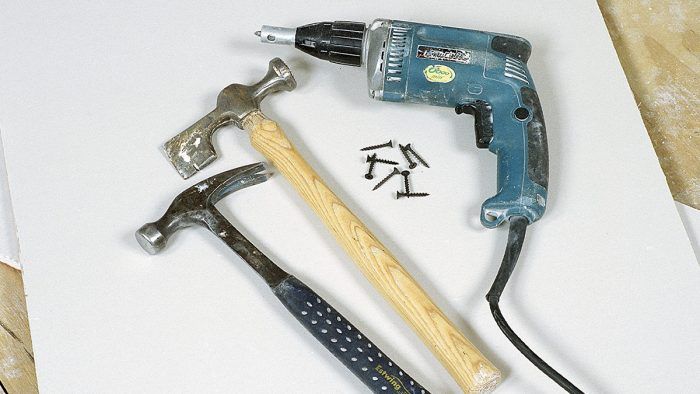Drywall Fasteners and Fastening Tools
Most installers prefer screws to hang drywall, but a few still use nails.

Drywall can be hung with nails or screws. If you use nails, you’ll need a drywall hammer, which looks a little like a hatchet. The blade end is tapered (but not sharp), so it can be used for prying or lifting. The hammer has a convex face, which leaves a shallow dimple in the front of the drywall without tearing the face paper (a standard carpenter’s hammer has a flat face, which can easily tear the paper). The dimple is concealed with joint compound during the taping process.
Nowadays, most professional drywallers use screws rather than nails, and the drywall screw gun has replaced the hammer as the tool of choice for attaching panels. A screw gun installs a screw with a bugle head just below the surface of the drywall paper. The nose of the screw gun pushes the drywall panel against the framing as the screw is installed. It has a positive clutch that is engaged when pressure is applied to the Phillips bit. When using a screw gun, the depth of the screw bit can be modified; when properly adjusted, the screw gun sets the screw just below the surface without tearing the face paper. Both corded and cordless models are available.
Screwing is faster than nailing, but having to place every screw onto the bit by hand is time-consuming (and tedious). A self-feeding screw gun solves that problem. Or you can buy a self-feeding attachment for your current screw gun. A string of screws feeds into the nosepiece as each screw is used, greatly increasing productivity. Self-feeding screw gun attachments are available to fit most brands; they accept screws from 1 in. to 1¾ in. long.
|
|
|
| WORK SMART: No matter which type of fastener you use be sure the panel is tight against the framing and that the fasteners are properly set. Always use fasteners of the recommended length. |
Screws and Nails
Fastening drywall with screws is preferred over nailing, because screws are faster to install than nails, they do less damage to the drywall panel, and they hold the drywall tighter against the framing. Screws for wood framing should be long enough to penetrate the framing at least 5/8 in. (see the chart below). Screws for light-gauge metal framing have finer threads than wood framing screws; they should penetrate at least 3/8 in. Use self-tapping screws for heavier gauge metal. (Note that you should always use screws in metal studs—nails will not hold.)
If you do use nails, they should penetrate the wood framing at least 3/4 in. Ring-shank nails are preferred over plain-shank nails because they have 25 percent greater holding power. (The holding power is greatly diminished if the drywall face is damaged, so be careful not to tear the paper or sink the nail too deep, which can severely damage the gypsum core.)
Whenever drywall is attached directly to wood, I like to use drywall adhesive as well. Adhesive acts as a supplement to the screws and even reduces the number of screws you need to use. The drywall adhesive adds shear strength to the structure and greatly reduces fastener pops and loose panels.




